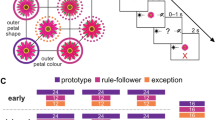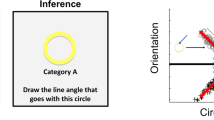Abstract
Real-world categories often contain exceptions that disobey the perceptual regularities followed by other members. Prominent psychological and neurobiological theories indicate that exception learning relies on the flexible modulation of object representations, but the specific representational shifts key to learning remain poorly understood. Here, we leveraged behavioral and computational approaches to elucidate the representational dynamics during the acquisition of exceptions that violate established regularity knowledge. In our study, participants (n = 42) learned novel categories in which regular and exceptional items were introduced successively; we then fitted a computational model to individuals’ categorization performance to infer latent stimulus representations before and after exception learning. We found that in the representational space, exception learning not only drove confusable exceptions to be differentiated from regular items, but also led exceptions within the same category to be integrated based on shared characteristics. These shifts resulted in distinct representational clusters of regular items and exceptions that constituted hierarchically structured category representations, and the distinct clustering of exceptions from regular items was associated with a high ability to generalize and reconcile knowledge of regularities and exceptions. Moreover, by having a second group of participants (n = 42) to judge stimuli’s similarity before and after exception learning, we revealed misalignment between representational similarity and behavioral similarity judgments, which further highlights the hierarchical layouts of categories with regularities and exceptions. Altogether, our findings elucidate the representational dynamics giving rise to generalizable category structures that reconcile perceptually inconsistent category members, thereby advancing the understanding of knowledge formation.



Similar content being viewed by others
References
Ahn, S., Zelinsky, G. J., & Lupyan, G. (2021). Use of superordinate labels yields more robust and human-like visual representations in convolutional neural networks. Journal of Vision, 21(13), 13. https://doi.org/10.1167/jov.21.13.13
Ashby, F. G., Alfonso-Reese, L. A., Turken, A. U., & Waldron, E. M. (1998). A neuropsychological theory of multiple systems in category learning. Psychological Review, 105(3), 442–481. https://doi.org/10.1037/0033-295x.105.3.442
Ashby, S. R., Bowman, C. R., & Zeithamova, D. (2020). Perceived similarity ratings predict generalization success after traditional category learning and a new paired-associate learning task. Psychonomic Bulletin & Review, 27(4), 791–800. https://doi.org/10.3758/s13423-020-01754-3
Bates, D., Mächler, M., Ben, B., & Walker, S. (2015). Fitting linear mixed-effects models using lme4. Journal of Statistical Software, 67(1), 1–48. https://doi.org/10.18637/jss.v067.i01
Bein, O., Plotkin, N. A., & Davachi, L. (2021). Mnemonic prediction errors promote detailed memories. Learning & Memory, 28(11), 422–434. https://doi.org/10.1101/lm.053410.121
Blair, M. R., Watson, M. R., & Meier, K. M. (2009). Errors, efficiency, and the interplay between attention and category learning. Cognition, 112(2), 330–336. https://doi.org/10.1016/j.cognition.2009.04.008
Braunlich, K., & Love, B. C. (2019). Occipitotemporal representations reflect individual differences in conceptual knowledge. Journal of Experimental Psychology. General, 148(7), 1192–1203. https://doi.org/10.1037/xge0000501
Brunec, I. K., Robin, J., Olsen, R. K., Moscovitch, M., & Barense, M. D. (2020). Integration and differentiation of hippocampal memory traces. Neuroscience & Biobehavioral Reviews, 118, 196–208. https://doi.org/10.1016/j.neubiorev.2020.07.024
Castro, L., Yang, S., Savic, O., Sloutsky, V., & Wasserman, E. (2021). Not all exceptions are created equal: Learning of exceptions in pigeons’ categorization. Psychonomic Bulletin & Review, 28(4), 1344–1353. https://doi.org/10.3758/s13423-021-01912-1
Davis, T., Love, B. C., & Preston, A. R. (2012). Learning the exception to the rule: Model-based FMRI reveals specialized representations for surprising category members. Cerebral Cortex (New York, N.Y.: 1991), 22(2), 260–273. https://doi.org/10.1093/cercor/bhr036
de Leeuw, J. R. (2015). jsPsych: A JavaScript library for creating behavioral experiments in a Web browser. Behavior Research Methods, 47(1), 1–12. https://doi.org/10.3758/s13428-014-0458-y
Erickson, M. A., & Kruschke, J. K. (1998). Rules and exemplars in category learning. Journal of Experimental Psychology: General, 127(2), 107–140. https://doi.org/10.1037/0096-3445.127.2.107
Favila, S. E., Samide, R., Sweigart, S. C., & Kuhl, B. A. (2018). Parietal representations of stimulus features are amplified during memory retrieval and flexibly aligned with top-down goals. Journal of Neuroscience, 38(36), 7809–7821. https://doi.org/10.1523/JNEUROSCI.0564-18.2018
Ferko, K. M., Blumenthal, A., Martin, C. B., Proklova, D., Minos, A. N., Saksida, L. M., Bussey, T. J., Khan, A. R., & Köhler, S. (2022). Activity in perirhinal and entorhinal cortex predicts perceived visual similarities among category exemplars with highest precision. eLife, 11, e66884. https://doi.org/10.7554/eLife.66884
Folstein, J., Palmeri, T. J., Van Gulick, A. E., & Gauthier, I. (2015). Category Learning Stretches Neural Representations in Visual Cortex. Current Directions in Psychological Science, 24(1), 17–23. https://doi.org/10.1177/0963721414550707
Goldstone, R. L., Lippa, Y., & Shiffrin, R. M. (2001). Altering object representations through category learning. Cognition, 78(1), 27–43. https://doi.org/10.1016/S0010-0277(00)00099-8
Heffernan, E. M., Schlichting, M. L., & Mack, M. L. (2021). Learning exceptions to the rule in human and model via hippocampal encoding. Scientific Reports, 11(1), 21429. https://doi.org/10.1038/s41598-021-00864-9
Hulbert, J. C., & Norman, K. A. (2015). Neural differentiation tracks improved recall of competing memories following interleaved study and retrieval practice. Cerebral Cortex (New York, N.Y.: 1991), 25(10), 3994–4008. https://doi.org/10.1093/cercor/bhu284
Jiang, X., Bradley, E., Rini, R. A., Zeffiro, T., VanMeter, J., & Riesenhuber, M. (2007). Categorization Training Results in Shape- and Category-Selective Human Neural Plasticity. Neuron, 53(6), 891–903. https://doi.org/10.1016/j.neuron.2007.02.015
Johansen, M. K., & Palmeri, T. J. (2002). Are there representational shifts during category learning? Cognitive Psychology, 45(4), 482–553. https://doi.org/10.1016/S0010-0285(02)00505-4
Juárez, F.P.-G., Sicotte, T., Thériault, C., & Harnad, S. (2019). Category learning can alter perception and its neural correlates. PLOS ONE, 14(12), e0226000. https://doi.org/10.1371/journal.pone.0226000
Kim, G., Norman, K. A., & Turk-Browne, N. B. (2017). Neural differentiation of incorrectly predicted memories. The Journal of Neuroscience, 37(8), 2022–2031. https://doi.org/10.1523/JNEUROSCI.3272-16.2017
King, M. L., Groen, I. I. A., Steel, A., Kravitz, D. J., & Baker, C. I. (2019). Similarity judgments and cortical visual responses reflect different properties of object and scene categories in naturalistic images. NeuroImage, 197, 368–382. https://doi.org/10.1016/j.neuroimage.2019.04.079
Konkle, T., & Alvarez, G. A. (2022). A self-supervised domain-general learning framework for human ventral stream representation. Nature Communications, 13(1), Article 1. https://doi.org/10.1038/s41467-022-28091-4
Kriegeskorte, N., & Mur, M. (2012). Inverse MDS: Inferring dissimilarity structure from multiple item arrangements. Frontiers in Psychology, 3. https://www.frontiersin.org/article/https://doi.org/10.3389/fpsyg.2012.00245
Kruschke, J. K. (1992). ALCOVE: An exemplar-based connectionist model of category learning. Psychological Review, 99(1), 22–44. https://doi.org/10.1037/0033-295X.99.1.22
Livingston, K. R., Andrews, J. K., & Harnad, S. (1998). Categorical perception effects induced by category learning. Journal of Experimental Psychology: Learning, Memory, and Cognition, 24(3), 732–753. https://doi.org/10.1037/0278-7393.24.3.732
Love, B. C., Medin, D. L., & Gureckis, T. M. (2004). SUSTAIN: A network model of category learning. Psychological Review, 111(2), 309–332. https://doi.org/10.1037/0033-295X.111.2.309
Mack, M. L., Love, B. C., & Preston, A. R. (2016). Dynamic updating of hippocampal object representations reflects new conceptual knowledge. Proceedings of the National Academy of Sciences, 113(46), 13203–13208. https://doi.org/10.1073/pnas.1614048113
Mack, M. L., Love, B. C., & Preston, A. R. (2018). Building concepts one episode at a time: The hippocampus and concept formation. Neuroscience Letters, 680, 31–38. https://doi.org/10.1016/j.neulet.2017.07.061
Mack, M. L., Preston, A. R., & Love, B. C. (2020). Ventromedial prefrontal cortex compression during concept learning. Nature Communications, 11(1), Article 1. https://doi.org/10.1038/s41467-019-13930-8
Mathy, F., & Feldman, J. (2009). A rule-based presentation order facilitates category learning. Psychonomic Bulletin & Review, 16(6), 1050–1057. https://doi.org/10.3758/PBR.16.6.1050
Mullen, K. M., Ardia, D., Gil, D. L., Windover, D., & Cline, J. (2011). DEoptim: An R package for global optimization by differential evolution. Journal of Statistical Software, 40, 1–26. https://doi.org/10.18637/jss.v040.i06
Nosofsky, R. M. (1986). Attention, similarity, and the identification–categorization relationship. Journal of Experimental Psychology: General, 115(1), 39–57. https://doi.org/10.1037/0096-3445.115.1.39
Nosofsky, R. M., Palmeri, T. J., & McKinley, S. C. (1994). Rule-plus-exception model of classification learning. Psychological Review, 101(1), 53–79. https://doi.org/10.1037/0033-295x.101.1.53
Palmeri, T. J., & Nosofsky, R. M. (1995). Recognition memory for exceptions to the category rule. Journal of Experimental Psychology: Learning, Memory, and Cognition, 21(3), 548–568. https://doi.org/10.1037/0278-7393.21.3.548
Sakamoto, Y., & Love, B. C. (2006). Vancouver, Toronto, Montreal, Austin: Enhanced oddball memory through differentiation, not isolation. Psychonomic Bulletin & Review, 13(3), 474–479. https://doi.org/10.3758/BF03193872
Savic, O., & Sloutsky, V. M. (2019). Assimilation of exceptions? Examining representations of regular and exceptional category members across development. Journal of Experimental Psychology. General, 148(6), 1071–1090. https://doi.org/10.1037/xge0000611
Schapiro, A. C., Turk-Browne, N. B., Botvinick, M. M., & Norman, K. A. (2017). Complementary learning systems within the hippocampus: A neural network modelling approach to reconciling episodic memory with statistical learning. Philosophical Transactions of the Royal Society B: Biological Sciences, 372(1711), 20160049. https://doi.org/10.1098/rstb.2016.0049
Schlichting, M. L., Gumus, M., Zhu, T., & Mack, M. L. (2021). The structure of hippocampal circuitry relates to rapid category learning in humans. Hippocampus, 31(11), 1179–1190. https://doi.org/10.1002/hipo.23382
Schlichting, M. L., & Preston, A. R. (2015). Memory integration: Neural mechanisms and implications for behavior. Current Opinion in Behavioral Sciences, 1, 1–8. https://doi.org/10.1016/j.cobeha.2014.07.005
Theves, S., Neville, D. A., Fernández, G., & Doeller, C. F. (2021). Learning and Representation of Hierarchical Concepts in Hippocampus and Prefrontal Cortex. Journal of Neuroscience, 41(36), 7675–7686. https://doi.org/10.1523/JNEUROSCI.0657-21.2021
Wammes, J., Norman, K. A., & Turk-Browne, N. (2022). Increasing stimulus similarity drives nonmonotonic representational change in hippocampus. eLife, 11, e68344. https://doi.org/10.7554/eLife.68344
Wills, A. J., O’Connell, G., Edmunds, C. E. R., & Inkster, A. B. (2017). Progress in modeling through distributed collaboration: Concepts, tools and category-learning examples. In B. H. Ross (Ed.), Psychology of Learning and Motivation (Vol. 66, pp. 79–115). Academic Press. https://doi.org/10.1016/bs.plm.2016.11.007
Wills, A. J., & Pothos, E. M. (2012). On the adequacy of current empirical evaluations of formal models of categorization. Psychological Bulletin, 138(1), 102–125. https://doi.org/10.1037/a0025715
Yamauchi, T., Love, B. C., & Markman, A. B. (2002). Learning nonlinearly separable categories by inference and classification. Journal of Experimental Psychology: Learning, Memory, and Cognition, 28(3), 585–593. https://doi.org/10.1037/0278-7393.28.3.585
Acknowledgements
We thank E. Heffernan for the inspiration for the experimental design, G. Son for suggestions on data collection, and M. Schlichting for suggestions on data analysis. Our research is supported by the Natural Sciences and Engineering Research Council (NSERC) Discovery Grant to MLM (RGPIN-2017-06753), the Canada Foundation for Innovation and Ontario Research Fund (36601) to MLM, the Canada Institutes of Health Research (CIHR) Project Grant (PJT-178337) to MLM, the Brain Canada Future Leaders in Canadian Brain Research Grant to MLM, the Ontario Graduate Scholarship (OGS) to YX, the NSERC Canada Graduate Scholarship (CGS-M) to YX, and the NSERC Postgraduate Scholarship (PGS-D) to YX.
Author information
Authors and Affiliations
Corresponding author
Ethics declarations
Conflict of interest
The authors have no conflicts of interests to disclose.
Additional information
Publisher's Note
Springer Nature remains neutral with regard to jurisdictional claims in published maps and institutional affiliations.
Open practices statements
All the stimuli, behavioral and modeling data, and dissimilarity matrices generated via iMDS are available at https://osf.io/5d6vf/. Trial-by-trial data from the multi-arrangement task are available from the corresponding author upon request. None of the experiments was preregistered.
Supplementary Information
Below is the link to the electronic supplementary material.
Rights and permissions
Springer Nature or its licensor (e.g. a society or other partner) holds exclusive rights to this article under a publishing agreement with the author(s) or other rightsholder(s); author self-archiving of the accepted manuscript version of this article is solely governed by the terms of such publishing agreement and applicable law.
About this article
Cite this article
**e, Y., Mack, M.L. Reconciling category exceptions through representational shifts. Psychon Bull Rev (2024). https://doi.org/10.3758/s13423-024-02501-8
Accepted:
Published:
DOI: https://doi.org/10.3758/s13423-024-02501-8




